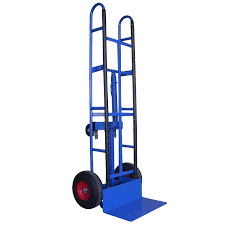Never stop innovating like with trolleys and hand trucks which can seem to be more mature products. Fibreglass and structural foam composite materials could produce lighter frames with the same load ratings, reducing operator fatigue. Haptic in the handle will soon warn users of the imminent overload castor hubs with built-in load cells. Interchangeable drive-assist modules fit onto stock axles, delivering push-to-go electric assist on climbs or lengthy spans before detaching for standard use when the battery depletes. These advanced surface coatings help mitigate and reduce microbial growth on the packaging and that of cold-chain pharmaceuticals so they are uh protected from contamination. Increased customisation by local, on-demand fabrication where managers pull route performance in simulated environment using digital twins before deciding to procure them in physical form. As autonomous mobile robots spread further, manual handling will remain necessary in innumerable situations; future versions will just grow more intelligent, lighter and even easier to use.
Utilize Trolleys and Trucks as Your Warehouse BFF
Whether for niche boutique fulfilment or sprawling Omni channel, at the core of every warehouse is the same fundamental problem; getting stuff in and out of the door as quickly and safely as possible. In the cacophony of nascent automation ideals, the trolley and hand trucks Melbourne remain trusted accomplices. They combine intuitive defence, responsive manoeuvrability, low maintenance needs and environmental friendliness to create an unrivalled value proposition.
Making the right model choice, caring for it properly, smartly embedding it in the digital landscape, and training up staff — these tools become potent drivers of productivity. In addition to this, warehouses procure a competitive advantage that is not measured in theoretical throughput numbers, but rather in the flow of materials in their everyday life, smooth and confident. And as the last carton for the day slides onto the despatch pallet with nary a sore back in sight, another day saves on the trolley and hand truck we can say with confidence is your warehouse best friend once again.
Innovations in Trolley Technology
Platform trolley innovation is fast-tracked, as seen with automation & big data. But powered drive assist, which once was limited to hospital beds and airport carts, has fast moved into industrial trolleys, allowing a single worker to move hundreds of kilograms up ramps or long distances with little effort. During a descent, regenerative braking systems can suck up kinetic energy that would otherwise have been converted to heat, and re-channel that energy into the battery, resulting in extended battery life and reduced charging frequency. Integrated load sensors that show weight in real time can avert accidental overloading while feeding data into warehouse management platforms for more thorough productivity analysis.
At Industry 4.0 workplace facilities, moreover, trolleys fitted with ultra-wideband tags relay locational information, allowing managers to see where hot spots of congestion appear and adjust traffic flows. Inserts for the deck accept cut foam cradles to protect fragile components one day, then switch to flat panels to facilitate carton picking the next. Even manual trolleys take advantage of advanced elastomer wheel chemistries for quiet rolling and resistance to metal chips or glass shards common in manufacturing.
Making Continuous Improvement Possible With The Perfect Platform Trolley
Purpose is not serendipitous or a by-product of software dashboards and corporate slogans. It is based on carefully selected tools that remove friction from every single task. The principle translates into something much more concrete in the notion of the platform trolley, which literally carries the load off the shoulders of employees so they can use their time to add value in skilled work, by making timely decisions, or attending to the customer.
By specifying capacity intelligently, designing for ergonomics, using durable components, embedding trolleys into the workflow, and maintaining the trolleys Melbourne scrupulously, an organisation lays a strong base for sustainable gains in efficiency. Throw in some future-facing capabilities like drive assist or live data capture, and the humble trolley evolves from a simple servant to an agile asset that supports new performance targets. Australian businesses move within a triangular field of labour costs and delivery expectations that invariably meet in the middle, with safety obligations adding weight to the cost of delivery. By delivering effort saving productivity toward each of those goals with the appropriate platform trolley, managers are ensuring each of those objectives at the same time, gaining practical benefits in turn — shift after shift, year after year.




